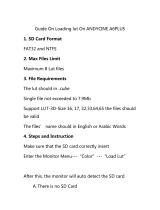
Contents
18
Section Index
D. Preparing the camera and shooting
Shutter speed is the easiest to understand and is similar
to how the shutter period would be expressed in a stills
camera. With Shutter Speed the shutter timing remains
fixed at the speed set even if you change the recording
frame rate (unless the shooting frame rate is increased
beyond the set shutter speed, in which case the shutter
speed will become set to the slowest possible speed for
the shooting rate chosen).
The Shutter Angle setting mimics the way the shutter
period of a movie film camera would be expressed. The
shutter in a film camera is a spinning circular disc, part
of which is cut away to allow light to fall on the film. The
most commonly used shutter angle is 180 degrees, which
is half of the 360 degrees of a full circle. So a 180 degree
shutter on a film camera would allow light to fall on the
film for half of the shutters rotation period. In a video
camera this means that the sensor will capture light for
half of the recording frame rate. For example, if shooting
at 24fps a 180 degree shutter will be open for half of 1/24
which is 1/48th of a second. With shutter angle, if you
change the recording frame rate the shutter speed will
also change as it will always be the same fraction of the
recording rate.




















